Best VPS Hosting Providers 2025: Virtual Private Servers Tested
We benchmarked the leading VPS plans to help you find the right one.
If you’re serious about hosting a website for professional or business purposes, a Virtual Private Server (VPS) plan is what you need. Unlike the cheap shared plans that many hosting services offer for as little as $2 or $3 a month, a VPS gives you dedicated CPU, RAM and storage resources, along with root access to your server. And, unlike dedicated servers, which cost a lot more for a dedicated box, VPS is affordable, flexible and performant at the same time.
We’ve tested the leading companies and identified the best VPS hosting providers to help you choose.
Quick List

Best VPS Web Hosting
Starting at $4.99 a month over two years, Hostinger is not only affordable but powerful and flexible at the same time.
✅ Hostinger VPS Hosting Plans

Best VPS Hosting Performance
The most performant VPS completes database queries way faster than the competition.

Best Cheap Shared Web Hosting
Good prices and solid performance and, even better, renewal prices after the sale term are cheap.

Best Cloud Web Hosting
Easy setup and very flexible. cPanel comes included.
✅ Bluehost Cloud Hosting Plans

Strong performance on database and WordPress benchmarks. Energy use offset by clean energy credits.

I've been developing websites and using web hosting services since most people were dialing in to AOL with 56K modems. I've built large databases in MySQL, programmed web tools in PHP and worked on the front end in HTML and JavaScript. I also maintain some of Future’s data-driven web tools. After having programmed many different sites, I understand what web developers of all skill levels (from beginners setting up a WordPress blog to programmers starting an online business) need from their VPS hosting providers.
How to Choose a VPS Hosting Provider
When shopping for a VPS provider, decide:
- Managed or Unmanaged? You can save money by purchasing an unmanaged VPS where you have nothing but a terminal and must install all your own software and updates. We recommend against this (and only test managed VPS plans), because the possibility of running into problems without support is too much of a hassle.
- Linux or Windows OS: This is a no-brainer. Unless you have a Windows-specific application you already run, go with Linux for lower costs, stronger performance and better stability.
- Monthly or annual? Don’t pay by the month. Sign up for two, three or four years if possible as you’ll lock in much lower monthly rates, and renewal rates after the initial term tend to be much higher.
- cPanel or other control panel? cPanel is the most popular and easiest-to-use control panel software, but even many of the best VPS providers charge significant licensing fees it, while offering reasonably capable alternatives for free.
- How much RAM, storage and CPU cores? For mid-range performance, we recommend a minimum of 4GB of RAM, 2 to 4 vCPUs (or CPU cores) and at least 60GB of storage. For larger sites with more databases, go for over 100GB.
Best VPS Hosting Plans 2025
Why you can trust Tom's Hardware
Best VPS Web Hosting
1. Hostinger VPS Plans
Specifications
Reasons to buy
Reasons to avoid
Plan | KVM 1 | KVM 2 | KVM 4 | KVM 8 |
|---|---|---|---|---|
Monthly Price (24-months) | $4.99 | $5.99 | $10.49 | $19.99 |
Monthly Price (renewal) | $8.49 | $11.49 | $24.99 | $47.99 |
CPU Cores | 1 | 2 | 4 | 8 |
RAM | 4GB | 8GB | 16GB | 32GB |
Disk Space | 50GB | 100GB | 200GB | 400GB |
Bandwidth | 4TB | 8TB | 16TB | 32TB |
Founded in Lithuania in 2004, Hostinger has grown into one of the world’s largest and most potent hosting services overall. It’s also one of the cheapest VPS providers while not skimping on performance.
Hostinger’s VPS plans start at just $4.99 per month with a 24-month commitment, though we’d recommend going with at least the KVM 2 plan which has two CPU cores, 8GB of RAM and 100GB of storage allotted. There’s also a generous 8TB of bandwidth allowed — enough to serve a lot of traffic.
The one thing you don’t get for these low prices is cPanel, the easiest-to-use and most powerful control panel software around. If you want cPanel, you have to pay an astonishing $23 a month in licensing fees, although there are other control panel options that are cheap or free. We tested the KVM 2 plan with Webmin / Virtualmin, which costs nothing extra and provides a pretty straightforward interface. Virtualmin is the user-facing panel that controls each website you build while the Webmin admin interface controls the physical server and the software it runs.
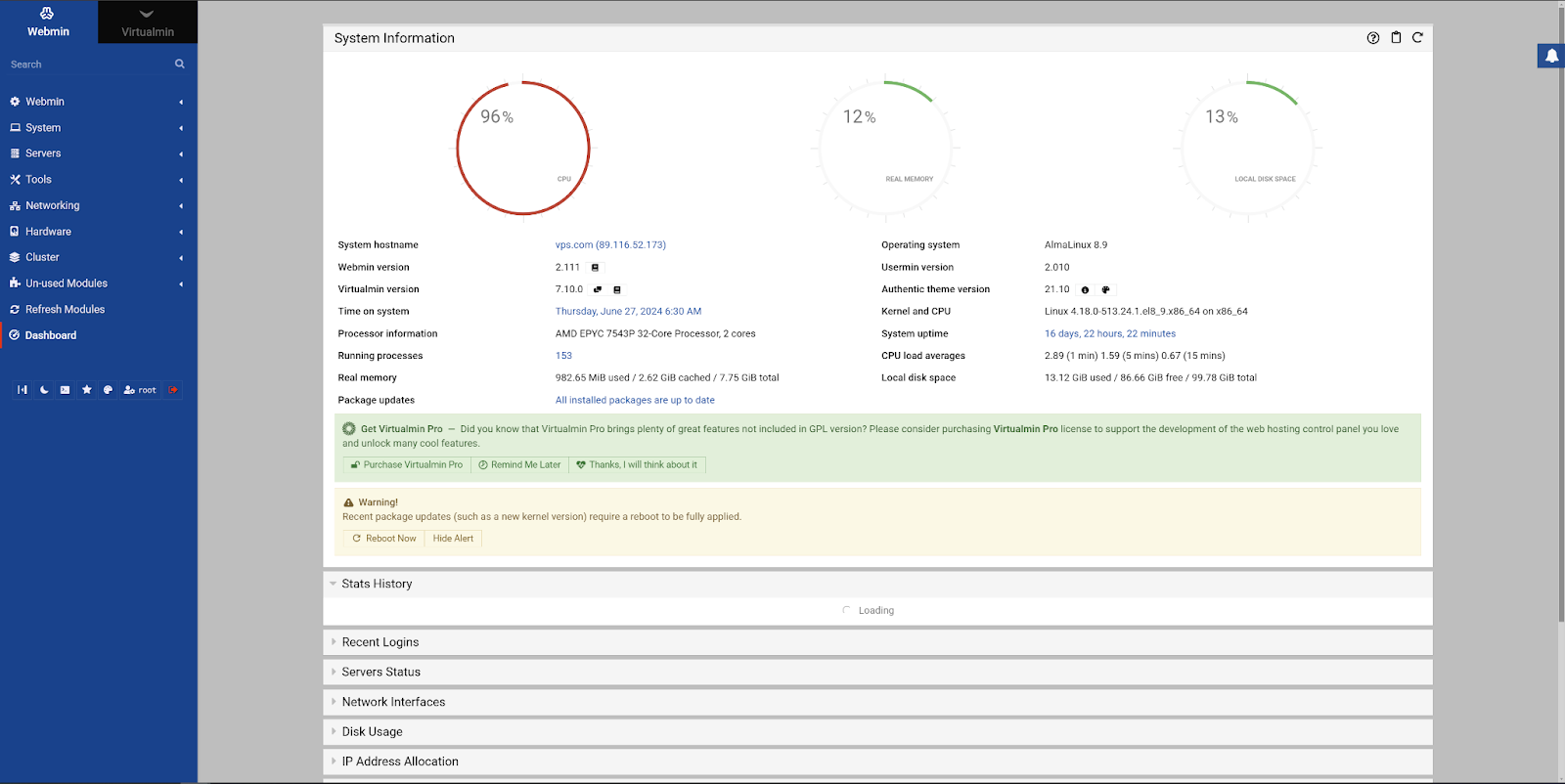
Hostinger doesn’t provide a lot of documentation on how to use the Virtualmin / Webmin combo, however. My default account came with a disk quota that prevented me from uploading all of my test files, for example, and I had to do some Googling to figure out how to change the limit.
Once we had our server set up, it was very easy to manage, run tests and build our website. Connecting via SSH was a snap, particularly because our account did not force us to use an encryption key (though we could have). We ran a number of scripts, including our endless script, and the system never killed them.
Our plan came preloaded with the 10.3.39 version of MariaDB, a popular MySQL-compatible database server, and the performance was top-notch. First, we used MySQL to insert millions of rows of old Tom’s Hardware page-view data, and Hostinger outperformed almost all of its competitors with the exception of Liquid Web (more on that later).
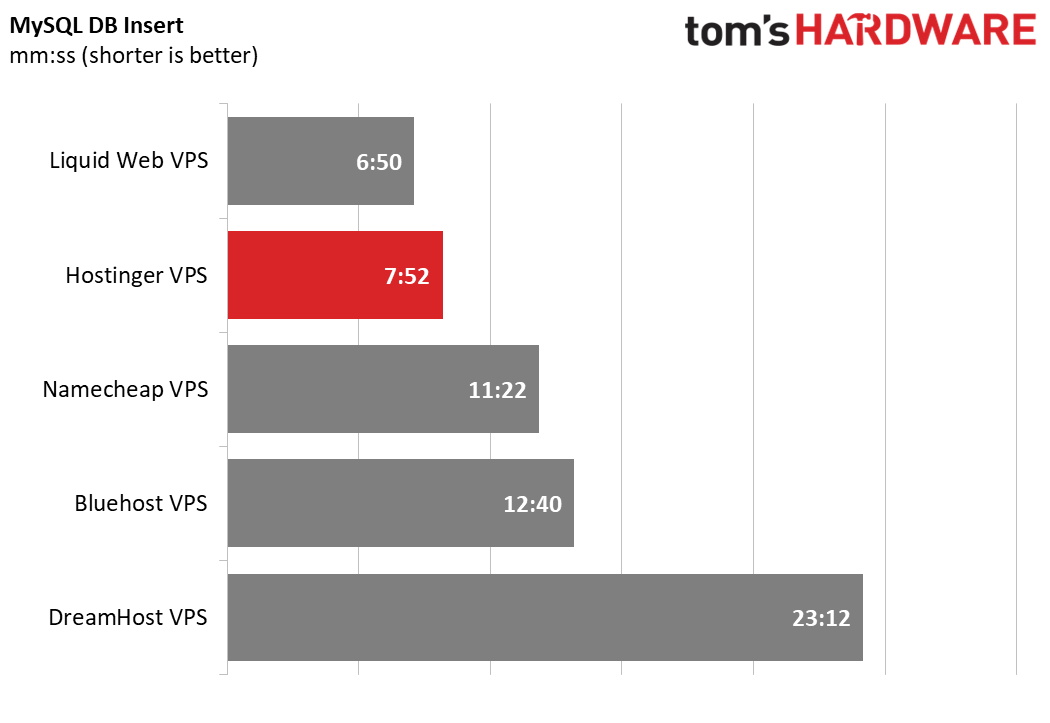
The times for our other DB tests, including one where we replaced all the original numbers with random numbers and another where we do a massive table JOIN, were equally impressive.
Hostinger’s VPS plan scored a very solid 7.4 on the WordPress Benchmark (where 10 is best). It also took just 1.9 seconds to load our sample WordPress site, which is within range of its competitors.
We found support solid, but unexceptional. There’s a knowledge base with a lot of information, but not much on Webmin / Virtualmin, the only free server control software. You can eventually do a live chat with a human, but we wish you could file an email ticket.
Overall, you get a lot of performance and flexibility for your money with Hostinger. It’s a winning combination and a value, even at the renewal prices.
Read More: Hostinger Review
Best VPS Performance
2. Liquid Web Managed VPS Plans
Specifications
Reasons to buy
Reasons to avoid
If you’re looking for the fastest performance around and can spend a bit more money, Liquid Web is the best VPS hosting provider for you. Founded in 1997, the company has over 180,000 clients and hosts data centers in Michigan, Arizona and Amsterdam. It owns some other hosting companies including Nexcess and Servers.com, and it offers a variety of managed and unmanaged hosting services.
We concentrated our testing on the managed VPS plans; unmanaged plans may be cheaper but also leave you with a lot more work when it comes to installing software, updating software and making sure your server is still running. The managed VPS plans on Liquid Web don’t come cheap, and their promotional period is only three months, so in reality you should just count on paying the non-promotional price when you make your calculations.
The Liquid Web managed VPS plans start at a regular price of $59 a month for 2GB of RAM and $99 a month for the plan we tested with 4GB of RAM. For that price, you get 4 CPU cores, 100GB of storage and a whopping 10TB of bandwidth.
Plan | 2 GB RAM | 4 GB RAM | 8 GB RAM | 12 GB RAM |
|---|---|---|---|---|
Monthly rate (first 3 months) | $29.50 | $49.50 | $69.50 | $84.50 |
Regular monthly rate | $59 | $99 | $139 | $169 |
CPU Cores | 2 | 4 | 8 | 12 |
RAM | 2GB | 4GB | 8GB | 12GB |
Storage | 40GB | 100GB | 150GB | 200GB |
Bandwidth | 10TB | 10TB | 10TB | 10TB |
Like many of its competitors, including Hostinger, Liquid Web does not come standard with cPanel control panel software, which costs extra if you want it. Instead we used the free InterWorx software, which is divided into SiteWorx (for website management) and NodeWorx (for server management). We found the UI, particularly in SiteWorx, pretty easy to navigate.
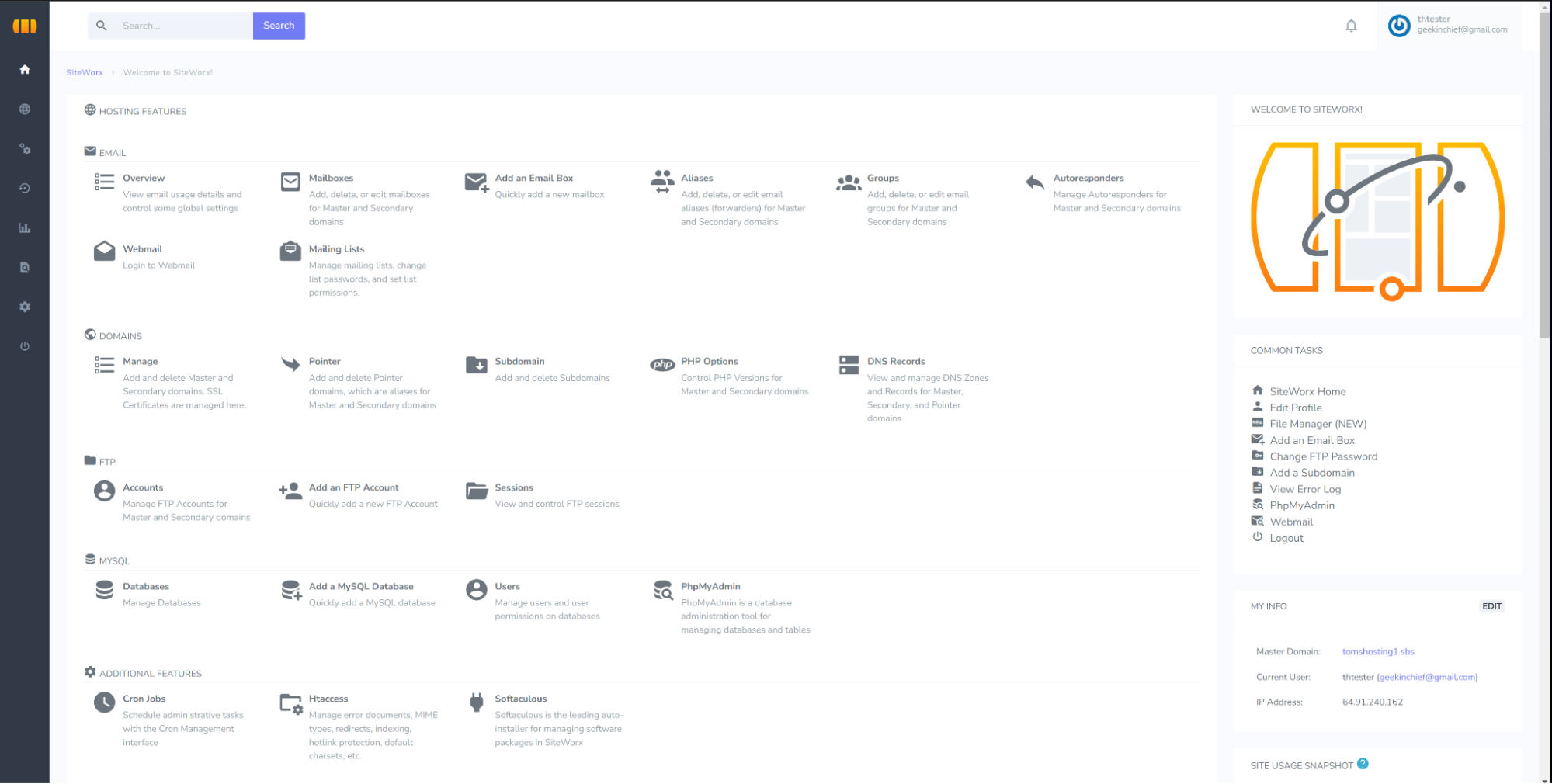
Liquid Web has a variety of means of contacting support. You can use live chat, telephone or email. We got our quickest response when using email.
Overall, the most important and impressive thing about Liquid Web is its performance, which eclipsed all other sites we tested on most benchmarks. It dominated the competition on all three database tests, including the very time consuming SUM and JOIN test, which has been known to take some competitors more than 20 minutes. Liquid Web’s was done in 8:42.
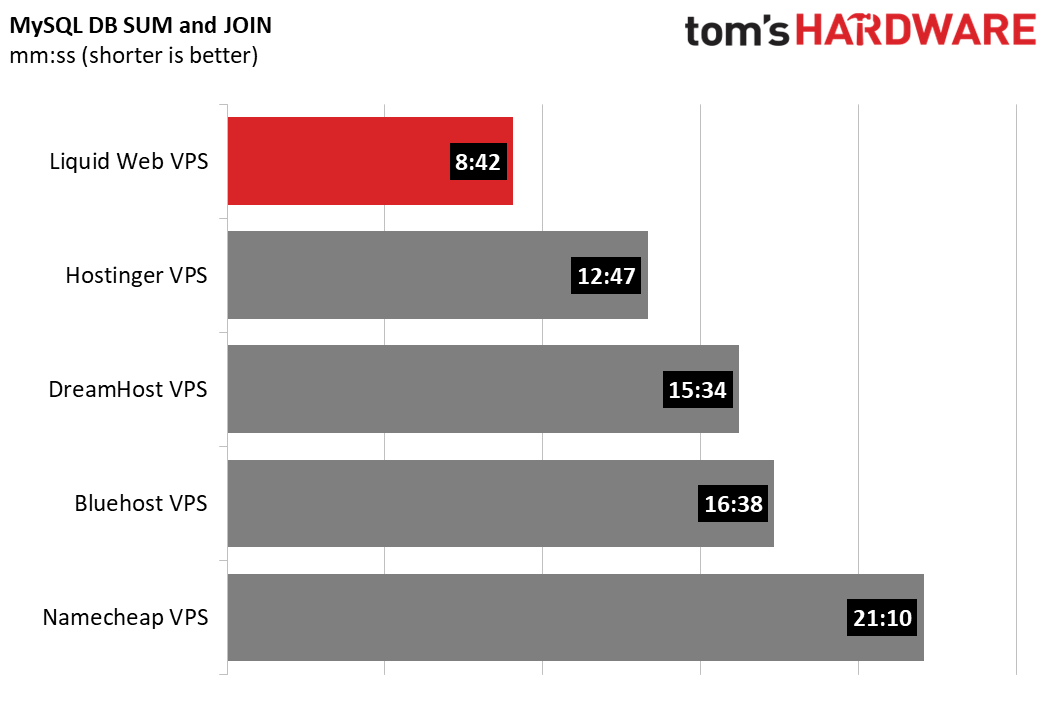
Liquid Web also aced the WordPress Benchmark, scoring 8.4 where most competitors are in the 7s. It did particularly well on the CPU operations portion of the test, scoring 9.21 out of a possible 10.
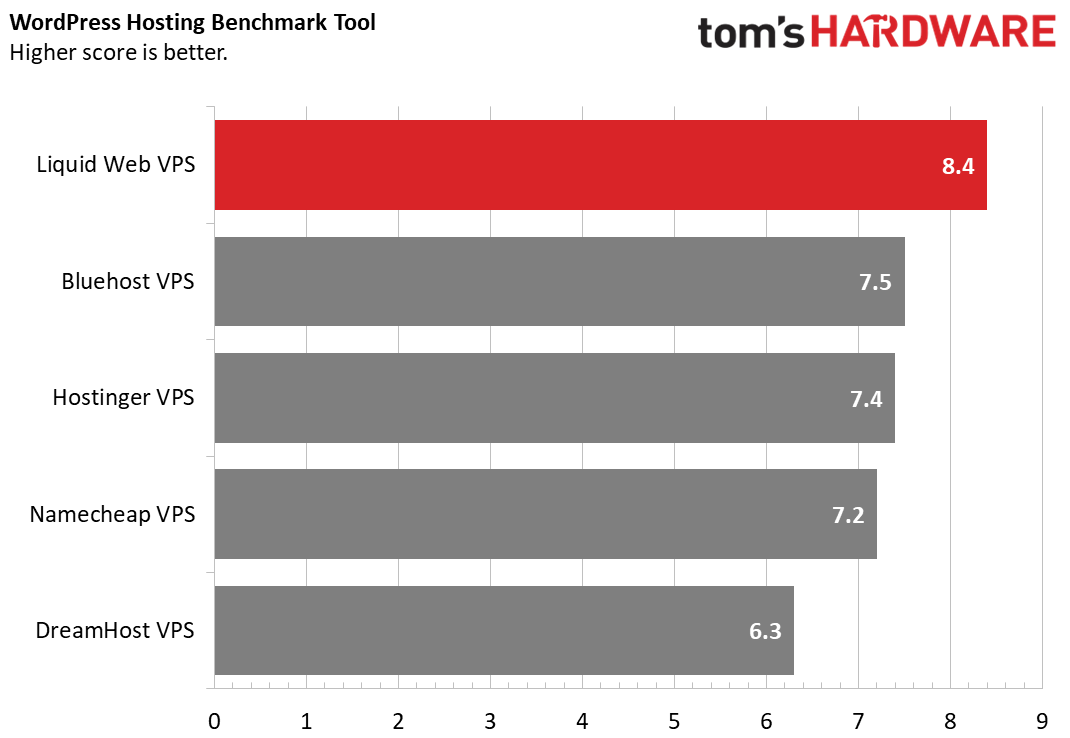
Liquid Web was also pretty quick to load our sample site, taking just 1.6 seconds
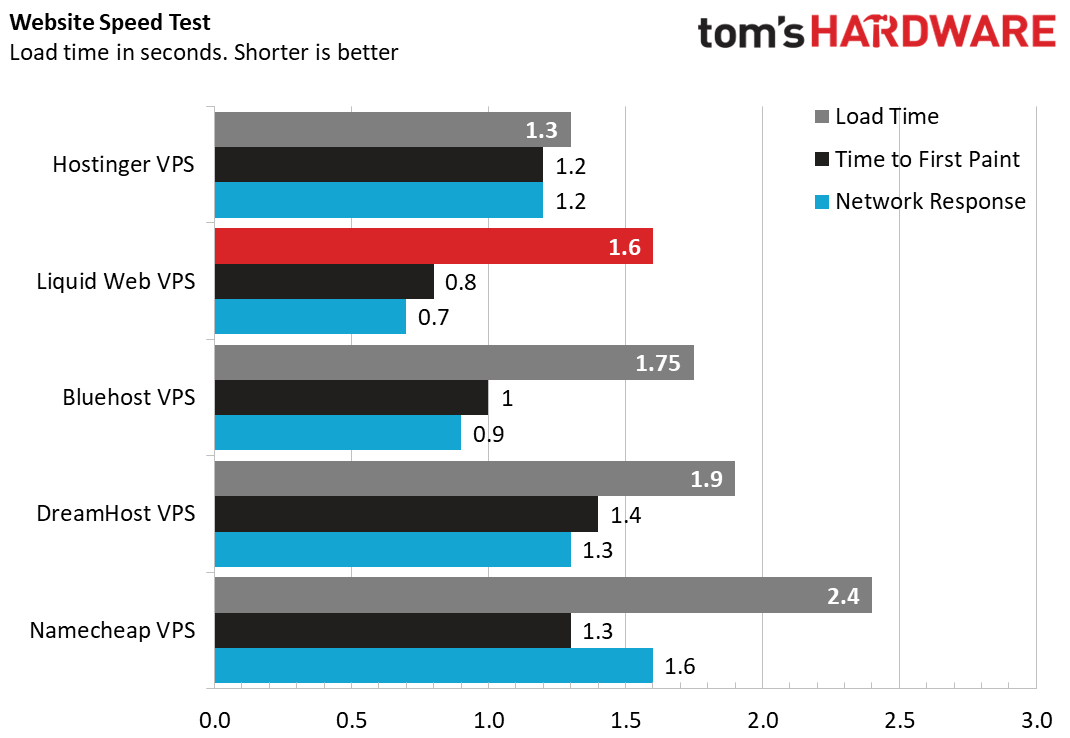
With 10TB per month of bandwidth, high-speed loading and high-speed data processing, Liquid Web’s VPS hosting plans are great for those expecting a lot of traffic.
Read More: Liquid Web Review
Best Cheap Shared Web Hosting
Specifications
Reasons to buy
Reasons to avoid
For 25 years, Arizona’s Namecheap has offered inexpensive domain registration services, which is where its name comes from. But the company also offers inexpensive hosting, including some of the best VPS plans you can get.
As its name implies, the plans are cheap, particularly if you want to pay annually and then keep going for more than a year — which any serious website would. The plans start at just $6.88 per month and go up to a mere $24.88 a month for 8 CPU cores. You get just a little more for your money with Hostinger, but Hostinger’s rates go up after the initial period while Namecheap’s stay the same, making it a better value over 24 months or more.
Plan | Pulsar | Quasar | Magnetar |
|---|---|---|---|
Monthly rate (annual sub) | $6.88 | $12.88 | $24.88 |
Renewal rate | $7 | $13 | $25 |
CPU Cores | 2 | 4 | 8 |
RAM | 2GB | 6GB | 12GB |
Storage | 40GB | 120GB | 240GB |
Bandwidth | 1TB | 3TB | 6TB |
If you’re building a larger site and expect a lot of traffic, note that the bandwidth limits are low on the first two plans.
As with many competitors, you have to pay extra for cPanel control software, to the tune of $10.88/month. There’s no completely free option so we went with Webuzo for just $2.88 a month. We found Webuzo’s UI easy to navigate and used it to enable SSL on our sample site and to turn on SSH remote access.
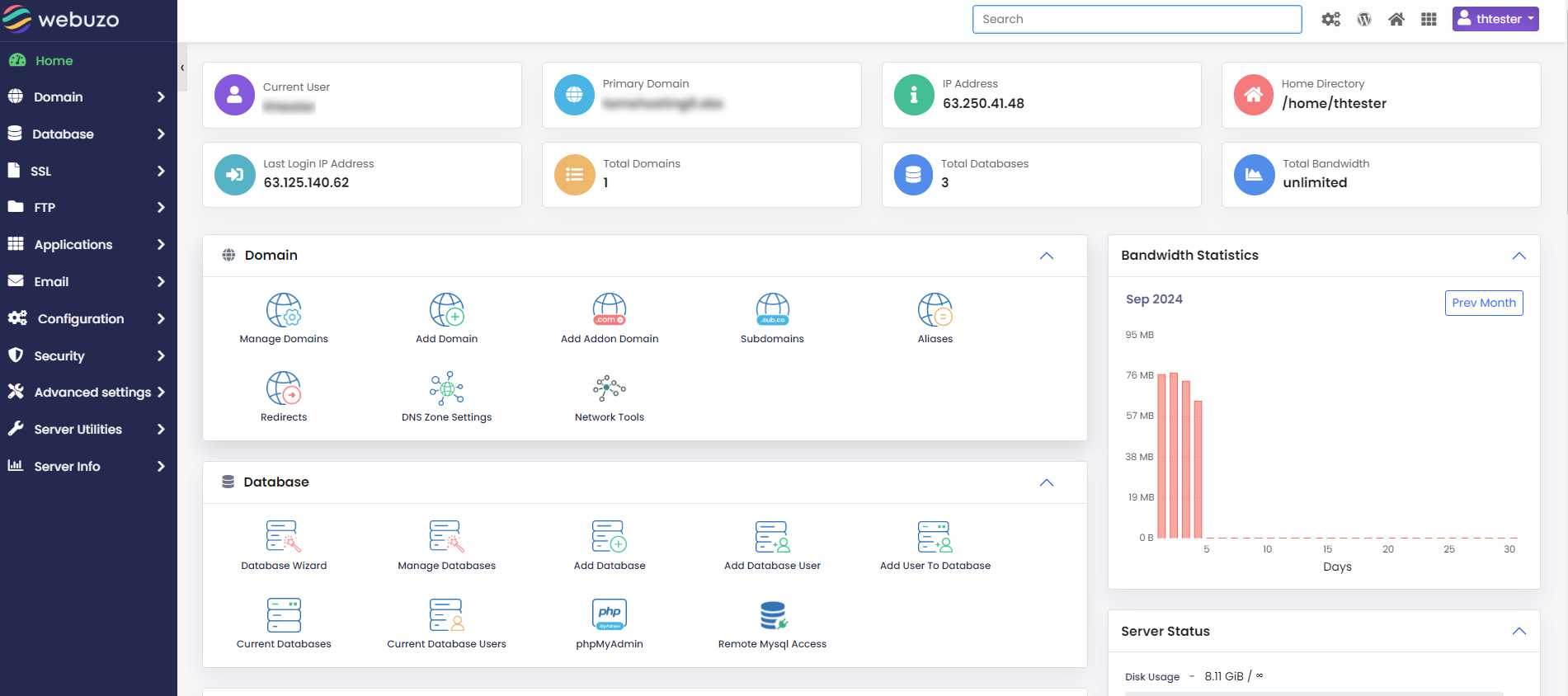
Performance-wise, Namecheap’s VPS places in the middle of the pack. It took a decent 11 minutes and 22 seconds, for example, to import our 4GB MySQL database file (filled with millions of Tom’s Hardware PV records), which is slower than Liquid Web and Hostinger but quicker than Bluehost or Dreamhost.
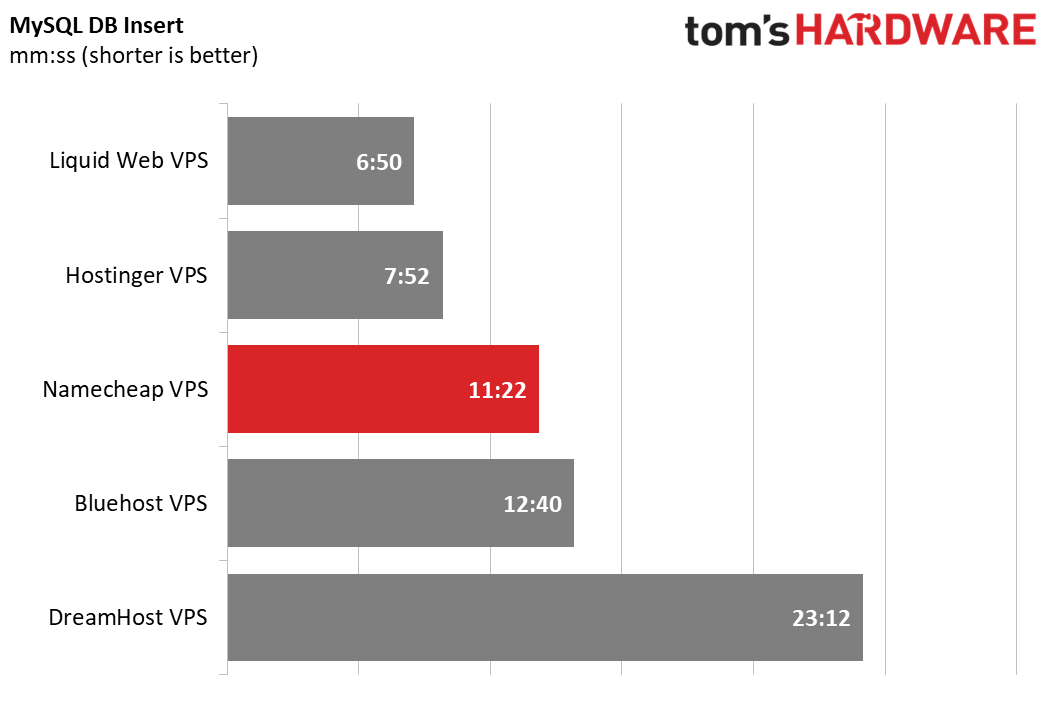
The load time test was less impressive, but still reasonable as Namecheap took an average of 2.4 seconds to load our sample site and a modest 1.6 seconds to network response.
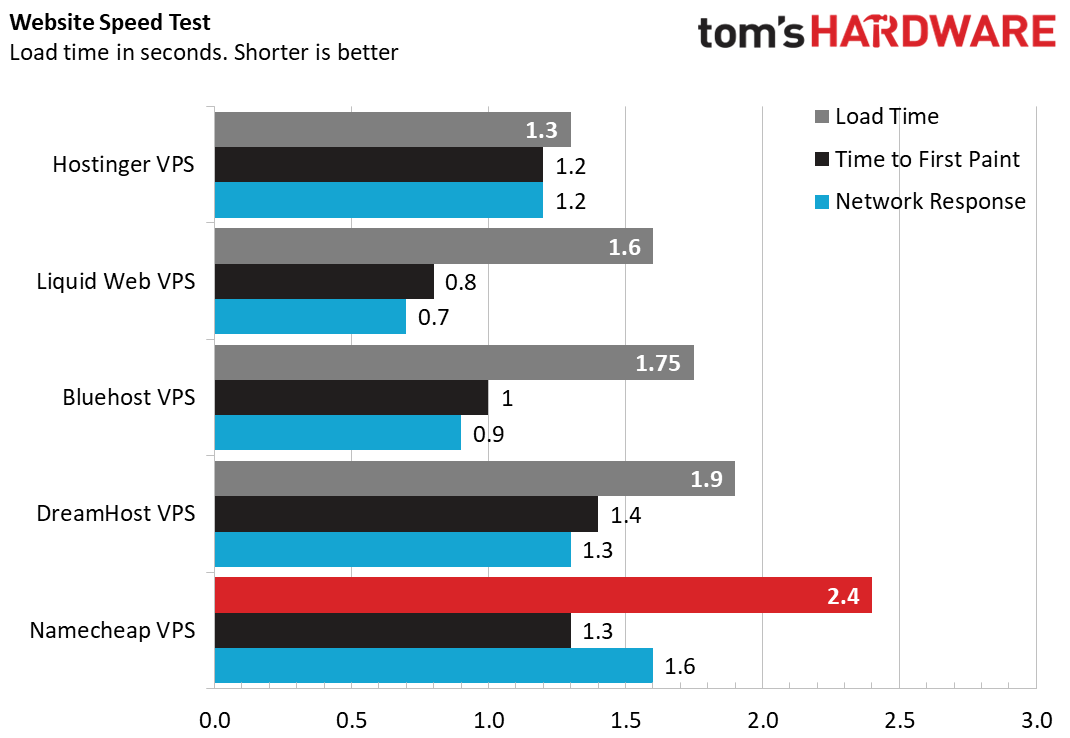
Overall, you get a lot of value, good flexibility and solid performance from Namecheap’s VPS offerings. Best of all, the renewal price is the same as the starting price.
Read More: Namecheap Review
Best Cloud Hosting
4. Bluehost Cloud Plans
Specifications
Reasons to buy
Reasons to avoid
In business since 2003, Bluehost is one of the largest hosting services around with more than 2 million customers. It’s owned by Newfold Digital, which also owns HostGator, another large hosting service that offers VPS.
Bluehost’s plans don’t come cheap, but they aren’t as pricey as Liquid Web’s offerings either. We definitely recommend going with a three-year contract, which means you have to pay all 36 months upfront but you get a significant discount. The plan we tested is one we signed up for a couple of years ago that supplies similar specs to Enhanced NVMe 8.
Plan | Standard NVMe 4 | Enhanced NVMe 8 | Ultimate NVMe 16 |
|---|---|---|---|
Monthly price (36-month commitment) | $46.99 | $65.99 | $94.99 |
Renewal monthly price | $66 | $96 | $141 |
CPU Cores | 2 | 4 | 8 |
RAM | 4GB | 8GB | 16GB |
Storage | 100GB | 200GB | 450GB |
Bandwidth | Unmetered | Unmetered | Unmetered |
We’ve been with Bluehost for several years now, long before we started testing web hosts, and we’ve used a couple of their plans. What we’ve seen is that Bluehost just works and is easy-to-use, particularly because cPanel, the powerful and simple control software that comes included. But our experience transferring a site to a new account was not good (they couldn’t get it working completely at the new server after several weeks) so we would recommend doing your own file transfer if you’re migrating from another service.
Bluehost’s performance on our three MySQL database tests was solid, mid-tier. For example on our randomization test, in which we have MySQL randomize and update all the traffic numbers in our sample database, Bluehost VPS finished in just 3 minutes and 6 seconds, which was faster than every other competitor except Liquid Web.
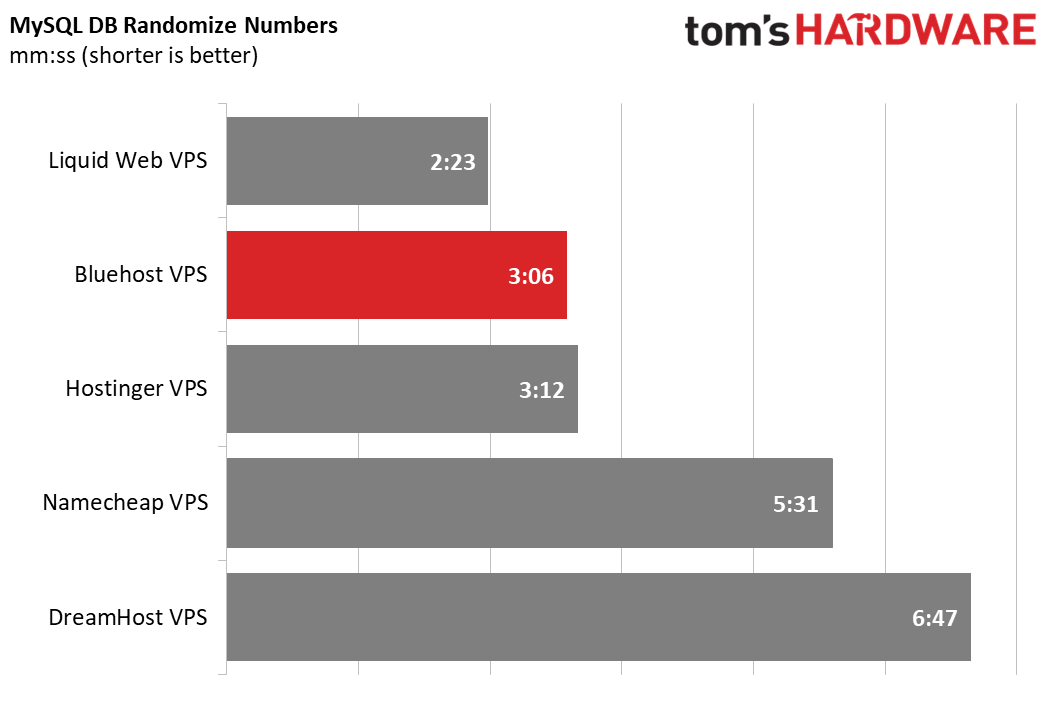
On the other hand, on the more intensive SUM and JOIN test, Bluehost finished behind Hostinger and DreamHost.
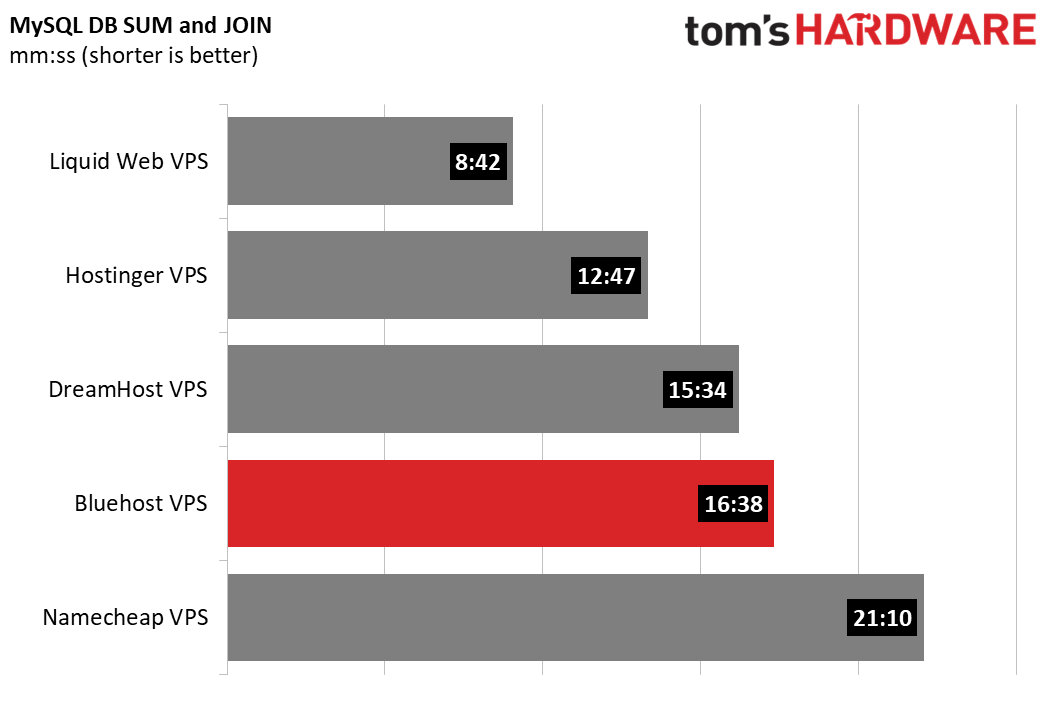
On the website speed test, Bluehost’s load times were middle-of-the-pack, with the network taking 0.9 seconds to respond and 1.75 seconds to load the entire site.
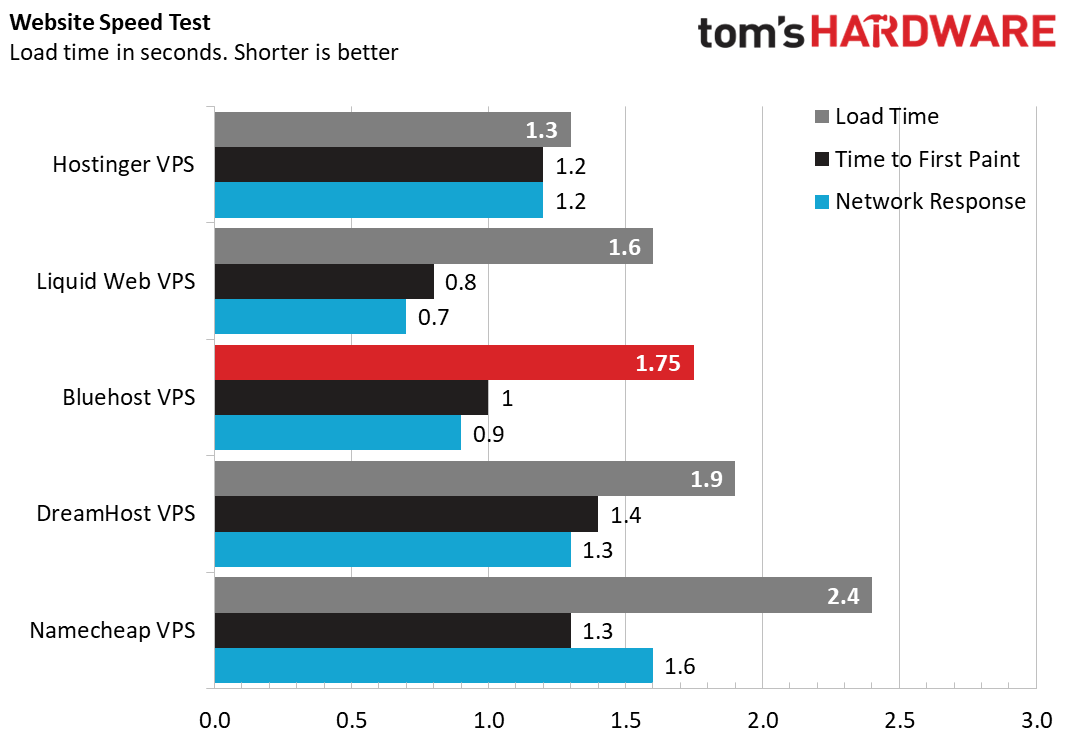
What we really like about Bluehost is how everything just works. In the years we’ve had the service, everything from setting up SSL to enabling new subdomains has been a snap. And we’ve never experienced an outage.
Our main beefs with the service are its middling support and somewhat high pricing. We wish it were easier to file support tickets – you need to wait for a live agent and deal with them. And, in our case, the transfer process of moving a site from one server to another required us to do the work. However, if you want a service that just works and works well, Bluehost is one of the best VPS hosting providers.
Read More: Bluehost Review
Best Shared Hosting
5. GreenGeeks Shared Plans
Specifications
Reasons to buy
Reasons to avoid
GreenGeeks, as its name implies, stands out from the competition by focusing on renewable energy. The company, which launched in 2010, replaces the power it uses for your account each month with 300 percent more electricity in wind-power credits. The company also claims that it plants a tree for each new account.
Going green with GreenGeeks is not cheap: The lowest-end plan costs $69 a month, with no discounts for purchasing years in advance. However, you do get cPanel included — and pretty good performance to boot.
Plan | 4GB | 8GB | 16GB |
|---|---|---|---|
Price per month | $69.95 | $129.95 | $179.95 |
CPU Cores | $4 | $6 | $6 |
RAM | 4GB | 8GB | 16GB |
SSD | 75GB | 150GB | 250GB |
Bandwidth | 10TB | 10TB | 10TB |
Like Bluehost, GreenGeeks comes with cPanel control panel (and WHM for controlling the server) as standard so there’s no fussing with less-than-intuitive software to set up your site.
Performance is pretty good. In our third MySQL database test, where we do a large table join and SUM, GreenGeeks VPS took only 14 minutes and 12 seconds. That’s faster than most competitors. It’s not the fastest when it came to importing the database, but operations on the database were pretty speedy.
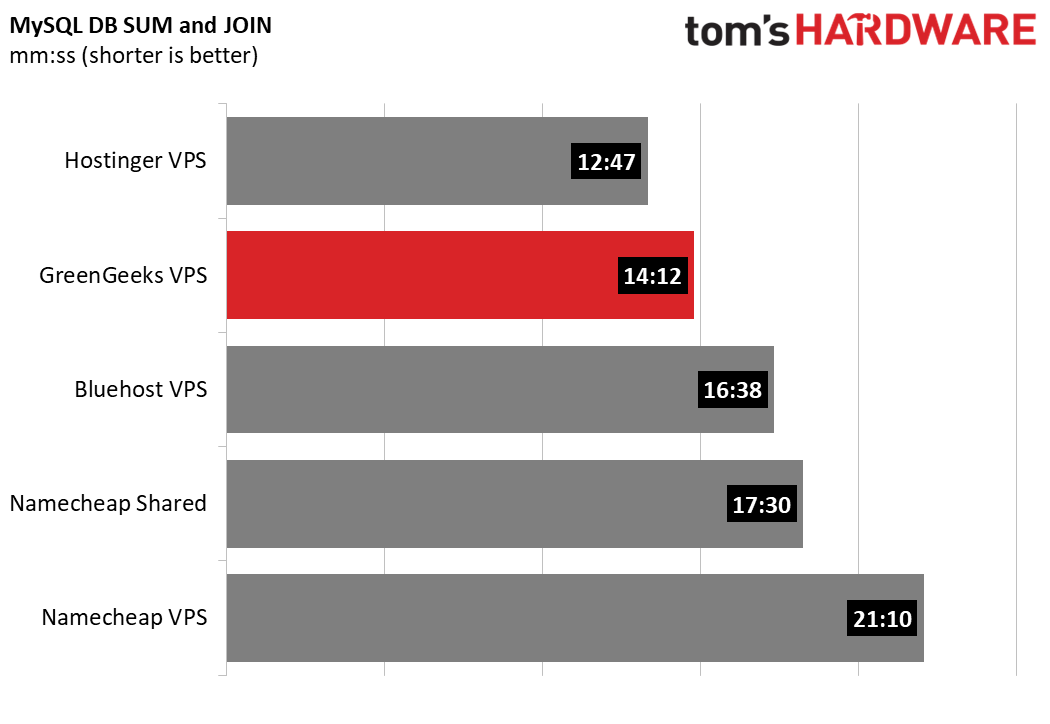
GreenGeeks VPS was also among the fastest to load, loading the complete home page of our sample Wordpress website in just 1.5 seconds. That’s pretty quick.
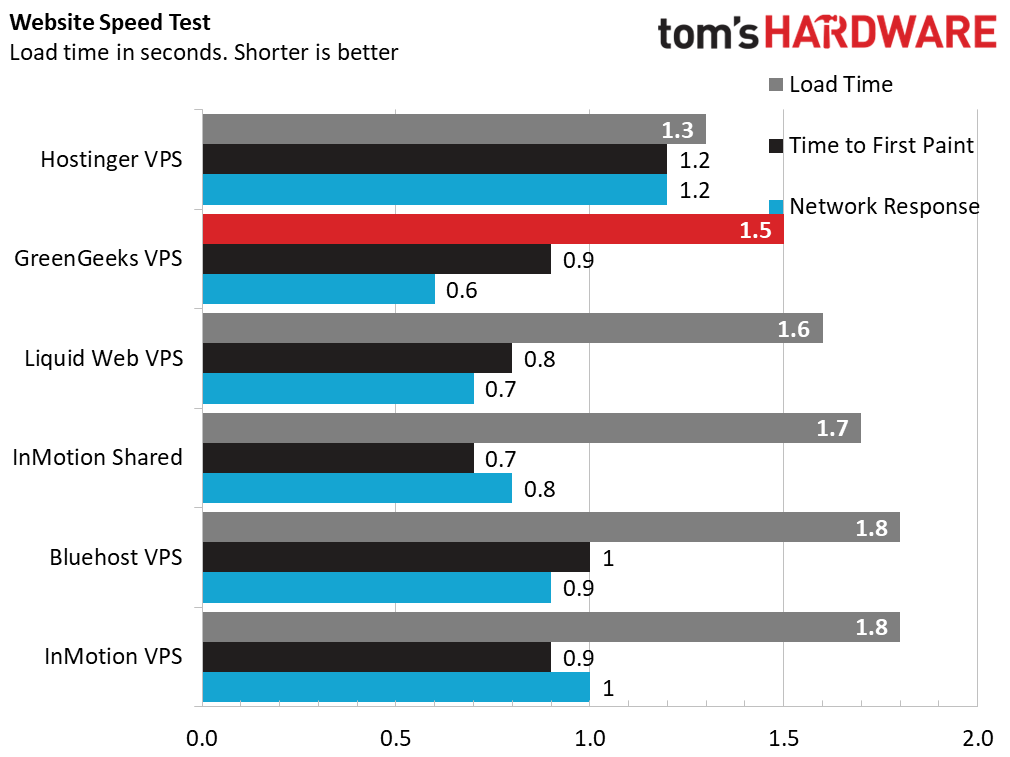
Read More: GreenGeeks Review
VPS Frequently Asked Questions
VPS FAQs
- What is a VPS? A Virtual Private Server combines the flexibility and admin access of a dedicated server with the price savings of shared hosting. You get dedicated CPU, RAM and storage resources while being part of a shared physical box that other customers use. In control panels, the VPS appears to be a separate machine.
- What’s the difference between VPS and shared hosting? In shared hosting, typically the cheapest form of web hosting, you don’t have admin access to your account and you don’t have a guaranteed set of resources such as CPU cores and RAM.
- What’s the difference between VPS and dedicated hosting? Dedicated hosting means you have your very own physical computer in the hosting company’s datacenter. This is usually at least double the cost of VPS and you often don’t get as many cores or as much RAM for the money.
- What’s managed hosting vs unmanaged? Managed hosting means that the hosting provider installs the basic software you need (such as control panels and database software) and keeps the server’s security up-to-date. Unmanaged hosting usually means that you get a command prompt and have to do everything else yourself.
- Is VPS hosting secure? VPS hosting should be just as secure as having a dedicated box. Your section of the server is completely isolated from all the other accounts.
How We Test VPS Hosting Providers
How We Test VPS Hosting Providers
We test each VPS provider in a few ways:
- We set up a sample WordPress blog that we use to test load times and run the WordPress Benchmark plugin. We test the load times using a combination of Dotcom-Tools’ Website Speed Test and the Apache benchmark.
- We import a large MySQL database with millions of records (based on old Tom’s Hardware traffic data). We then randomize all those page view numbers in a second operation and, in a third, we use a giant table JOIN to generate a SUM of page views for each page in the database. We perform each database operation three times and take the average completion time.
- We run an endless script that logs the time every minute so we can see if the VPS provider has a time limit on script execution.
Other VPS Hosting Providers We Tested
Other VPS Hosting Providers We Tested
We also tested the following VPS hosts, but they didn’t make the cut necessary to be named among the best VPS providers.
- HostGator VPS: The company offers decent, cPanel-enabled plans but they’re expensive and didn’t perform extremely well on our benchmarks.
- ScalaHosting VPS: Decent prices and a helpful control panel make this a solid choice, but performance was a bit below the competition.
- InMotion VPS: The prices are ok, but we got mediocre support in our tests and benchmark scores were unimpressive.
- DreamHost VPS: Prices are decent but database performance was pretty weak and human support was slow for us.
- A2 Hosting: Prices are decent, but database performance was among the slowest we saw.
Get Tom's Hardware's best news and in-depth reviews, straight to your inbox.
Avram Piltch is Managing Editor: Special Projects. When he's not playing with the latest gadgets at work or putting on VR helmets at trade shows, you'll find him rooting his phone, taking apart his PC, or coding plugins. With his technical knowledge and passion for testing, Avram developed many real-world benchmarks, including our laptop battery test.
-
kyzarvs I've used OVH for about 5 years.Reply
Had no downtime in that time, DDoS protection built-in, cheap and seem to work perfectly.





